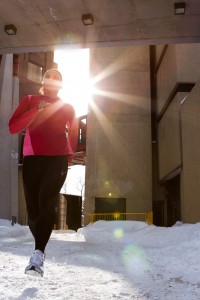
According to The American Council on Exercise the order that you do things in the gym is just as important as getting up and going to the gym. They recently did some research, and figured out what structure that your workout shoud follow. The order is important so that you can get the most out of your workout while you are at the gym.
The Study took 24 men and women between 18 and 39 years. They had them take part in 24 exercise sessions that included every possible workout order. The sessions combined cardio training, resistance exercise, neuromotor (agility, speed, and balance) exercises, and also had them performa flexibility component.
The results showed that cardio should be performed first (interestingly it's the opposite from what I do myself). They then say this should be followed by resistance training and then flexibility and neuromotor exercises in either order. It was found that when participants of the study performed cardio in the beginning that their average heart rate increased less than when it was performed last. Why is that good? The author's Lance Dalleck, Ph.D., says that is a good thing because too-vigorous exercise can lead to injury and increased risk of cardiac issues. And, doing resistance training second maximizes its effectiveness without making it feel too hard (score!). I myself do a light cardio warmup but I do my longer intervals or steady state cardio first. It was unspecified how long the cardio actually was from what I can find to date. Maybe it was just a short warmup.
It should also be noted that researchers did note that these results are not set in stone. “The order determined by this research stems from purely physiological findings, and it’s essential to know, for example, how sequencing affects cardiorespiratory performance and can account for that effect in the workout design,” says Cedric Bryant, Ph.D., ACE’s Chief Science Officer. And, Dr. Dalleck added, not every workout needs to include all four aspects. He goes on to say that, you should take your own personal preferences into account before changing your personal routine.
Therefore in my opinion if you want to maximize your workout, according to this research cardio should come first. However don't feel like you need to change your routine if it is already working for you just fine. Continue to #trainitright
Alicia Bell
@trainitright.com
www.trainitright.com
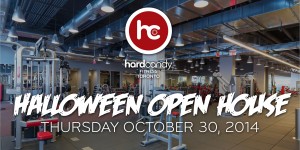
SPECIAL HALLOWEEN OPEN HOUSE!
Thursday October 30, 2014
Start your Halloween weekend off right and take advantage of our complimentary open invite to Hard Candy Fitness Toronto!
On October 30th, we’re opening the doors to you, your friends, family and co-workers for the entire day and ending it off with special performances, costume contests, and a Halloween social where you can enjoy some drinks and snacks on us! Don't worry, costumes are optional but we encourage you to get in the spirit.
Come in, workout, enjoy great music hosted by one of our special guest DJs, and be a part of the Hard Candy Fitness experience that so many of us have grown to call home. And, for all you trick or treaters out there, we're opening a very special membership promotion for one day only!
Please note: drinks and snacks will be served from 6:00pm to 10:00pm.
|
|
We're proud to have some of our Addicted to Sweat Dance instructors team up with dozens of our members for a special performance of Michael Jackson's 'Thriller'!
Join us in the Energy Studio at 8:30 pm to witness the original choreography of a dance music video that changed the way we experienced music videos.
This is going to be truly special! |
|
As a valued member you can benefit from our Open House event by participating in our Referral Incentives Program.
- Refer one new member that signs up at Hard Candy Fitness and you will receive 50% off your monthly dues for the next month.
- Refer three new members that sign up at Hard Candy Fitness and you will receive one-month free access your choice of one Specialty Class.
- Transformer
- Off the Wall Yoga
- Adrenaline
- Refer six new members that sign up at Hard Candy Fitness and you will receive $500 credit of services free at our club. Credit is applicable to:
- Specialty Classes
- Personal Training
- Juice Bar Items
|
|
Hey Guys!
I recently came across an awesome new product that is a kickstarted project. It was invented by a man named Eric and it is a massage track with balls. I think it's pretty cool and I could definitely use it for my clients and my athletes.
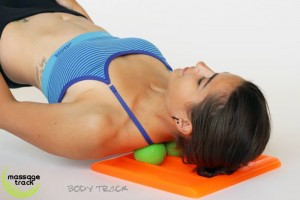
www.massagetrack.com
Or
https://www.kickstarter.com/projects/ericjeffrey/massage-track-how-2-tennis-balls-can-change-your-l
What is it?
Massage Track offers patent pending tools for doing deep tissue massage, either guided by a therapist or for self-care after instruction. The Body Track and Neck Track are both designed to position massage balls bilaterally, for example targeting the paraspinals. The tools accommodate ordinary tennis balls, lacrosse balls or baseballs but can also be purchased with a specially designed massage ball set of varying hardnesses.
How is it used?
The massage track tools are designed to function using gravity for comfort and power. The user rolls the tissue structure on top of the massage balls applying body weight, similar to the way you would use a foam roller. It’s very helpful to have a physical therapist guide the user initially to explain pressures, hold times and trigger point release.
What are the features?
Both the Body Track and Neck Track are soft polyurethane and pliable to avoid injury and designed to offer variable positioning. The Body Track has four tracks with two different spacings so that massage balls can be positioned very close to each other, a finger width apart or with one or two empty tracks in between them.
The variable spacing makes the body track especially useful for working the back, gluteus and hips, but can be used for much more. The Neck Track has close tracks on the top and a wider position on the bottom (to allow for targeting of the side of the neck or the jaw). The Neck Track’s height allows the user to comfortably release the suboccipital muscles but also can be used to target the psoas, gluteus and upper hamstring area.
What makes these tools unique?
- ability to customize the pressure easily by changing massage balls
- great versatility created by a variety of ball spacing options
- dual angles of pressure created by the track wall support
- great simplicity
Do you think that this is a product that you would use? Let me know in the comments below.
http://www.gofundme.com/ap6ta4
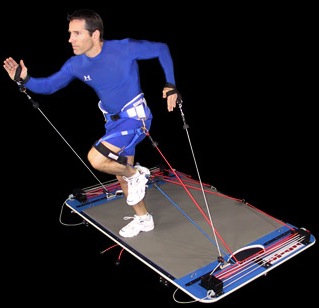
Coaching is my passion. I want all of my athletes and clients to be the best that they can be. We are raising funds for a piece of equipment that would help my athletes reach their goals. Please donate to give these athletes an opportunity to train with equipment that the pro's use. Click HERE to donate.
The secret to a flat stomach is to strengthen your core muscles. You have probably heard trainers or other health professionals in the gym talking about how having a “strong core” is important, but if you’re like most people, you may not know exactly what that means, why it’s important or how to strengthen it.
WHAT IS YOUR CORE?
Most health care professionals use the word “core” to describe the different muscles that are is located in the middle section of your body as a whole. Many people think that the core is just the abdominal muscles. Although they are part of what makes up your core it actually includes your diaphragm (lower chest), abdomen (belly), obliques (sides), mid-lower back, and lower pelvic muscles. Add all of these muscles up and you get a total of 25 different muscles that make up your core.
WHY YOUR CORE IS IMPORTANT
Your core is where your body’s strength and stability comes originates. It is part of what is called a “kinetic chain” that allows the various parts of your body to function correctly. These muscles are critical for optimal athletic performance, daily activities (e.g., sitting, walking, running, reaching, bending, climbing stairs, to name a few). As our bodies age, it becomes increasingly important to do core strengthening exercises so that you can avoiding injuries and maintain an independent, healthy and active life.
STRENGTHENING YOUR CORE
To strengthen your core, it’s important to focus on keeping your belly button pulled in, a flat back and to remember not to hold your breath.
Try these exercises below For For endurance. Hold each one as long as you can. Repeat 2-3x.


Try these exercises below For For strength. Do each leg for 10-20 reps then switch. Repeat 2-3x.


Alicia Bell is a Toronto based Personal Trainer.
For more exercise tips follow Alicia Bell on Twitter.
My Experience At A Toronto Nike NTC Class

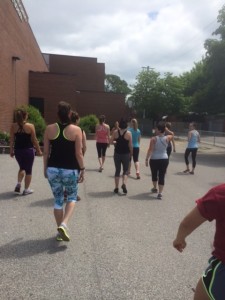
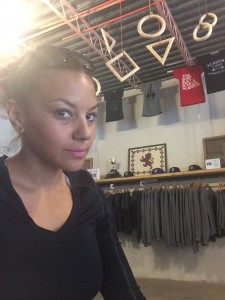
I love Nike. I love the NTC app and I see on twitter and Instagram all these great events that they have. It seems as though most of the NTC events are in the states. America has tons of amazing trainers that are Nike NTC trainers or affiliates but here in Canada. I only know of one Nike Trainer. I have no idea how they selected her or why. I've inquired to every outlet or anyone involved in Nike that I can get in contact with on how to apply, how to audition or how to become an influencer in Canada but no one can give me an answer. Or I get short turned with they're figuring out how to identify influencers. I just want to be part of a community of like minded trainers that genuinely care and do a good job at motivating people. I feel that having a Nike NTC trainer role is a great outlet to do just that. My passion is helping athletes and clients achieve goals and keeping them motivated.
So finally A few weeks ago I saw a post on Facebook about the Toronto Nike NTC classes. They posted a link showing you when the next classes were and gave a link to sign up. I sent a bunch of my clients e-mails and asked if they wanted to go. YAY Nike NTC events! A few of my clients were available and said yes. So we all registered. Leading up to the event I did not receive a reminder e-mail or any other sort of notification. Fine. Not a big deal since I put everything in my agenda.
Even though I was in an accident on May 29th I am limited to the things that I can do with both my hand and my knee. I am great at knowing my limitations and being able to modify exercises so I decided I would still participate (this was my first time working out since the accident), so I decided to still go.
Upon arrival at the Academy of Lions (where the event was held) there were signs for Nike NTC. I walked into the store front area of the gym and no one greater me, told me to register or had me fill out a waiver (which needs to be done or I could sue for injury and liability). I then noticed some girls coming in and signing in at the front desk. I signed in. No one spoke to me with any direction or information on where to wait. So I sat and observed. Then we saw a small sign on the entrance of the changing rooms that said Nike NTC register at front desk. A little late but there it was. About 10 minutes later the front desk guy from the gym comes up and asks myself and my client if we were new to the NTC class. We said yes and he said ok I will need to get you to sign a waiver. He left and came back to the group again with no waivers for us.
At this point the instructor came and said "ok guys lets run to the park like we always do." NO INTRODUCTION, NO QUESTIONS, DIDNT ASK IF ANYONE WAS NEW, DIDNT ASK IF ANYONE HAD ANY INJURIES, NOTHING! So we proceed to go to the park. Halfway through the warmup the instructor finally acknowledge that I had a knee injury and gave me one alternate to the exercise we were doing. OK THANKS! I proceeded to modify every other exercise given in the circuit training MYSELF. The workouts lasted approximately 35 minutes then a 10 minute stretch. Yes I worked up a sweat but it probably was because of the sun.
My experience with that particular NIKE NTC class at The Academy of Lions was sub par. The instructor was fit, but must be comfortable in her role. A simple welcome to NTC class would have been great and a bit of her background. A greeting at the club upon arrival would have been nice and a waiver presented to me would have been great. I wouldn't recommend this particular Saturday morning NTC class for very beginner exerciser. Very little exercise correction was offered, I don't think it was conducted safely and the instructors enthusiasm was less than stellar. Exercises were done on pavement (bad for joints, knees etc).
Overall I would rate the circuit style NTC bootcamp a 3/10. Now don't get me wrong. Im sure not all the classes are like this in Toronto or all the instructors are like this but I was very disappointed with my experience. Let me know if you have done a Nike NTC class and how your experience was in the comments below.
Did You See Train It Right in Impact Magazine's March/April Issue?
Alicia was asked to write an article about 5k and 10k training that included core speed. Did you pick up a copy?
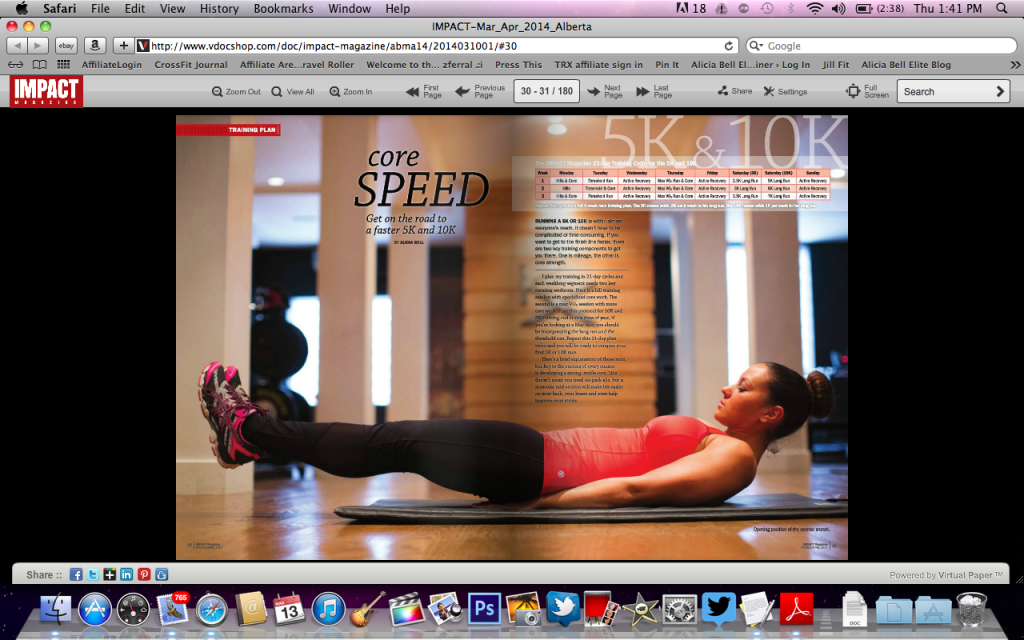
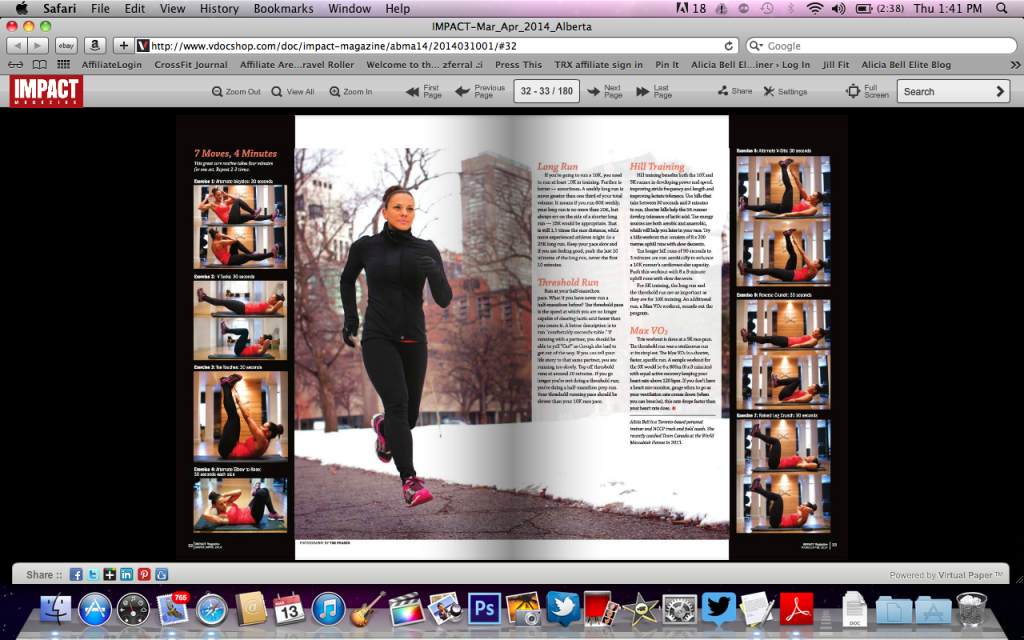
Reebok introduces The Official Shoe of FitnessReebok Cross fit Nano 3.0 is more colourful,
adaptable and robust than ever before
TORONTO, ON- Leading fitness brand, Reebok, has launched the third iteration of its popular Nano footwear series introducing updated technology, improvements and new colours for the Reebok CrossFit Nano 3.0 the shoe, is now available on shelves nation-wide. Dubbed the‘Official Shoe of Fitness’, the Reebok CrossFit Nano 3.0 is the top option for men and women looking for versatile training footwear.
One of the most visible additions to the Reebok CrossFit Nano 3.0 is the new Duracage upper – a composite part made up of a polyurethane frame cast directly into an air mesh to provide flexibility, protection and stability in a lightweight package. The thickness of the Duracage varies throughout the upper based on functional movements; some areas are thicker to provide more lateral stability and rope protection, and other areas have strategically placed textures that offer grip, durability and flexibility.
In addition to the Duracage, the zoned mesh upper provides breathability in the tongue; the lateral and medial quarter mesh have excellent cooling and strength properties and the vamp mesh is slightly tighter to provide added durability. A new anti-shift gusset in the tongue keeps it in place, secured over the top of the foot.
“At Reebok, we are focused on building product for functional movement, and our Reebok CrossFit footwear takes this philosophy to the extreme,” said Michael Rossi, vice president, Reebok Canada. “The evolution of the Nano franchise demonstrates that we are always working to build the best, most functional products out there. The Reebok CrossFit Nano 3.0 is designed to withstand the toughest workouts, and is the ultimate training shoe, whether used in a CrossFit box, at the gym or anywhere else you can work out. This is why wecall it the Official Shoe of Fitness.”
For this generation of the shoe, Reebok made significant improvements to the out sole as well. The low-profile, flat-to-the-ground out sole has two levels of traction: bigger lugs for overall grip, smaller grooves that help to disperse water, dust and chalk, and Metasplit grooves that allow for metatarsal splaying and multi-directional flexibility. New foam composites in the heel and forefoot provide better stability for lifting and heavy squats, and responsiveness for movements with rebounding like running, box jumps and double unders.
The new RopePro Outsole technology is designed to provide grip and slip, regardless of your climbing technique. This highly abrasive-resistant material has an asymmetrical design, with moulded lines on the medial side for added grip, and a smooth lateral side to make descending a rope more efficient.
The Reebok CrossFit Nano 3.0 retails for $130 and is available for both men and women at Sport Chek, Sports Experts and online at www.reebok.ca.

Reebok Nano 3.0
About Reebok:
Reebok International Ltd., headquartered in Canton, MA, USA, is a leading worldwide designer, marketer and distributor of sports, fitness and casual footwear, apparel and equipment. An American-inspired global brand, Reebok is a pioneer in the sporting goods industry with a rich and storied heritage in running, training and fitness. A subsidiary of the adidas Group, Reebok operates under the multiple divisions of the Reebok brand, Reebok-CCM Hockey and the Sports Licensed Division. For more information, visit Reebok at www.reebok.com.
Website: Reebok.ca
Hashtag: #RCFNano3
Twitter: @ReebokCanada
Facebook: Reebok
YouTube: Reebok
About CrossFit
CrossFit, Inc. is the world's foremost developer of functional fitness programming and a leading accredited certificate issuer for physical training professionals worldwide. Founded by Greg Glassman, CrossFit® is the principal strength and conditioning program for hundreds of accomplished and professional athletes and hundreds of thousands of individuals seeking to achieve elite fitness.
CrossFit offers specialty certificate courses and programs, including the CrossFit Kids program; publishes the CrossFit Journal; and created and operates the CrossFit Games, an annual event which seeks to find and crown the Fittest on Earth™. There are currently more than 3,000 affiliated gyms in the global CrossFit training network.
For more information, please visit www.crossfit.com, http://www.facebook.com/crossfithqor http://www.youtube.com/user/CrossFitHQ. CrossFit is a registered trademark and 3,2,1..Go!, Fittest on Earth and The Sport of Fitness are trademarks of CrossFit, Inc. in the U.S. and/or other countries |
For some strange reason, range of motion in the fitness world seems to be completely misunderstood with trainers having their clients only do partial range movements saying its full range (partial does not mean full) and trainees performing these ranges. So with this in mind I will quickly explain what Range of Motion or ROM actually is in a human movement setting:
WHAT IT IS
Range of motion (ROM) is as its name suggest, the range to which a body part can move properly in space while attached to another. Typically what this means is how many degrees of flexion or extension a joint can go thru. Here are 3 prime examples of full ROM:
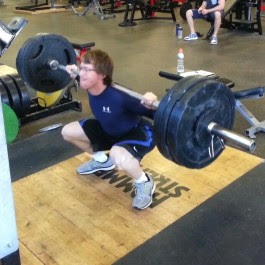
- Squats: While maintaining a flat/neutral back position, bending at the knees, hips and ankles one lowers their buttocks until the hamstring covers the calf while the feet remain flat on the ground.
- Bench Press (any barbell variation): Keeping the shoulders and glutes on the bench, one bends their elbows and shoulder joint lowering the bar until it is in contact with the chest
- Pull/Chin-up: Starting from a full hang (elbows are not flexed), pull the body up by bending the elbow and shoulder until the chin has passed the bar and until the forearm and bicep have made contact.
So what does this mean?
First take a look at any joint in the human body, the joint has a range of motion that it was designed to be able to go thru whether under additional external resistance or not. Many people will advocate that full ROM training will damage the joint and these people are what I like to call……..WRONG!
By training the joints thru their entire range of motion, this will actually make the joint healthier than continuous partial range training.............
To read the full article please visit: http://rislingperformance.wordpress.com/2014/04/28/what-is-range-of-motion/

Flirty Girl Fitness in Toronto is having an Open House. Check it out below:
Customer Appreciation Night & Open House Party!
Thursday April 10, 4:30PM-9:30PM
Join us this Thursday for free flowing pink cocktails & munchies. Lots of prize giveaways in every class & of course FREE CLASSES ALL NIGHT!
First Timers Welcome.
Punchcard Holders Don't Need Your Cards.
Members Get a Special Gift Bag
Just a Few of the Prize Giveaways:
Fifth Night Club - Bottle Service for 8 for the Perfect Girl's Night Out Party
Hammam Gift Certificate for a Dermalogica Facial, Shellac Manicure & Hammam Steam
Kara Scalp Salon - Revolutionary Holistic Approach to Detox Your Hair & Scalp
Fresh Gift Certificate - Our Favorite Super Healthy Vegetarian Restaurant
Degree Anti-Perspirant for Everyone
Lara Bars for Everyone
Schwarskopf Gift Basket Full of Amazing Hair Products
And so many more....
Check out our schedule below and call 416.920.1400 to register or go online.
|
|
|
|


















